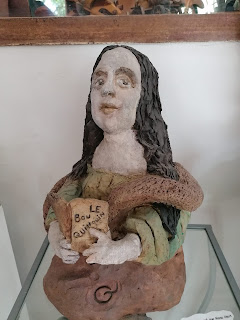 |
| pictures courtesy of Dominique Clément |
The distance of the built-up areas of the two French municipalities of Auterive and Boucagnéres that border each other, is some 3 km. Both municipalities are located along the Gers, a river flowing in a northerly direction.
A little south of Auterive, where the frontiers of Auterive and Boucagnères meet, is the small hamlet of La Meillanc.
Here, in La Meillance, a footpath along the Gers towards Auterive starts. It is a rather special footpath because it has been decorated in recent years with an extensive series of wooden sculptures.
This sculpture trail was created by Raymond Dasee, about whom virtually no biographical information is available on the internet.
So far, what has been published about this art environment and its creator remains limited to two articles in the regional newspaper La Dépèche, as mentioned in the documentation.
However, there is a large series of photos available, made by Dominique Clément, which can be seen in this post and partly on his Facebook page (see documentation)
Raymond Daste started his decorative project a few years ago, around 2019. It is possible that he started doing this when he had just retired. In a photo in one of the articles in the journal la Dépêche he is depicted with two friends who helped him transport a large sculpture and the gentlemen look in their late fifties, early sixties.
It is understandable that friends sometimes have to help him install a creation, if we look at the very first image.
The image shows a wooden sculpture representing a Tyrannosaurus. It's a creation of 3.50 meters high, 6 meters long and weighing about 700 kilos. Compare the height of the sculpture with the height of the person standing in the background.
Most of the creations have a more modest size, although in general the are life-size, such as a fisherman, a hunter, a rabbit and a hare...
On the other hand, there is also a snake of four meters in length and a crocodile of considerable size, as shown in the image below.
Raymond Datse makes his creations using a chainsaw and the wood he works with is mostly from the poplar. Making a large sculpture takes him about three months.
The European field of art environments has only a limited number of sculpture trails. Some countries with such a creation, reviewed in this weblog, are:
- Scotland:
Frank Bruce (this trail collapsed in 2024 in a storm)
Documentation
* Article (8-3-2021) in regional journal
La Dépêche * Another
article (26-7-2023) in
La Depêche *
Entry (10-8-2023) on the Facebook-page of Dominique Clement
Raymond Daste
Sculpture trail along the Gers
Auterives, dept Haute Garonne, region Occitanie, France
can be visited freely
visitors arriving by car could park in Boucagnères and walk to la Meillanc,
or park in the south of Auterives and walk towards Boucagnères


























